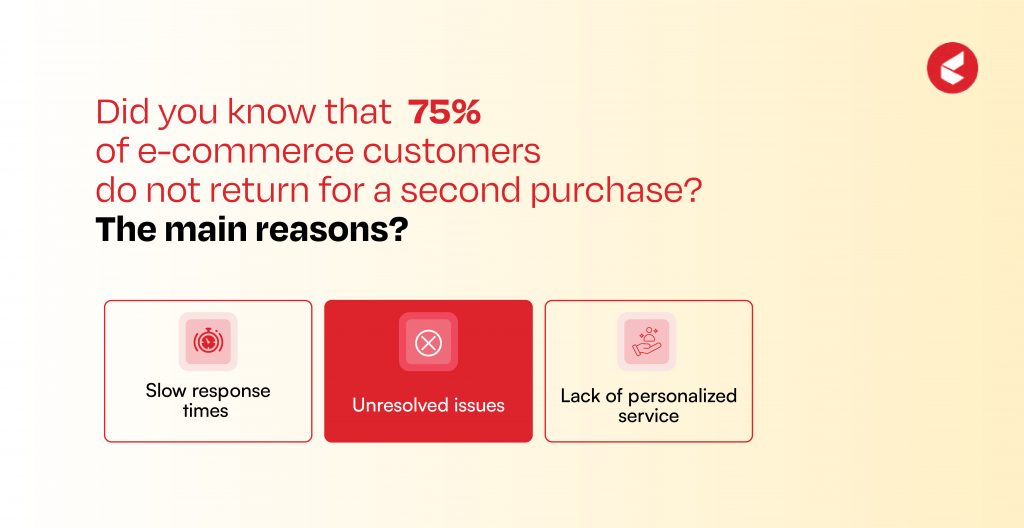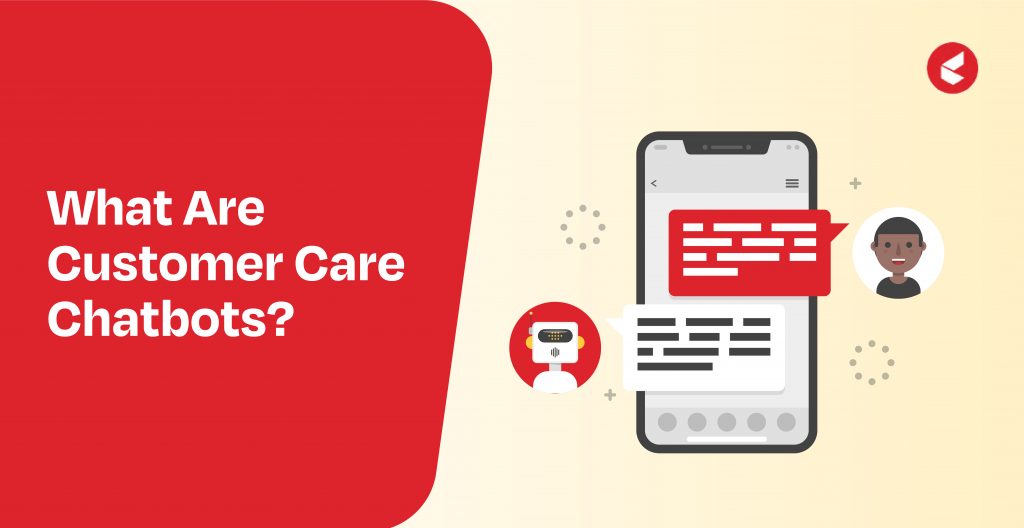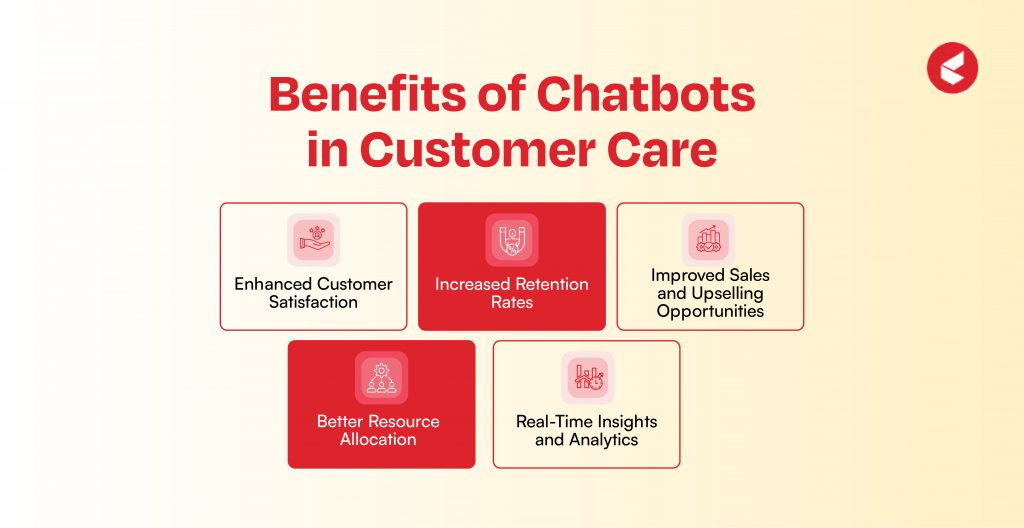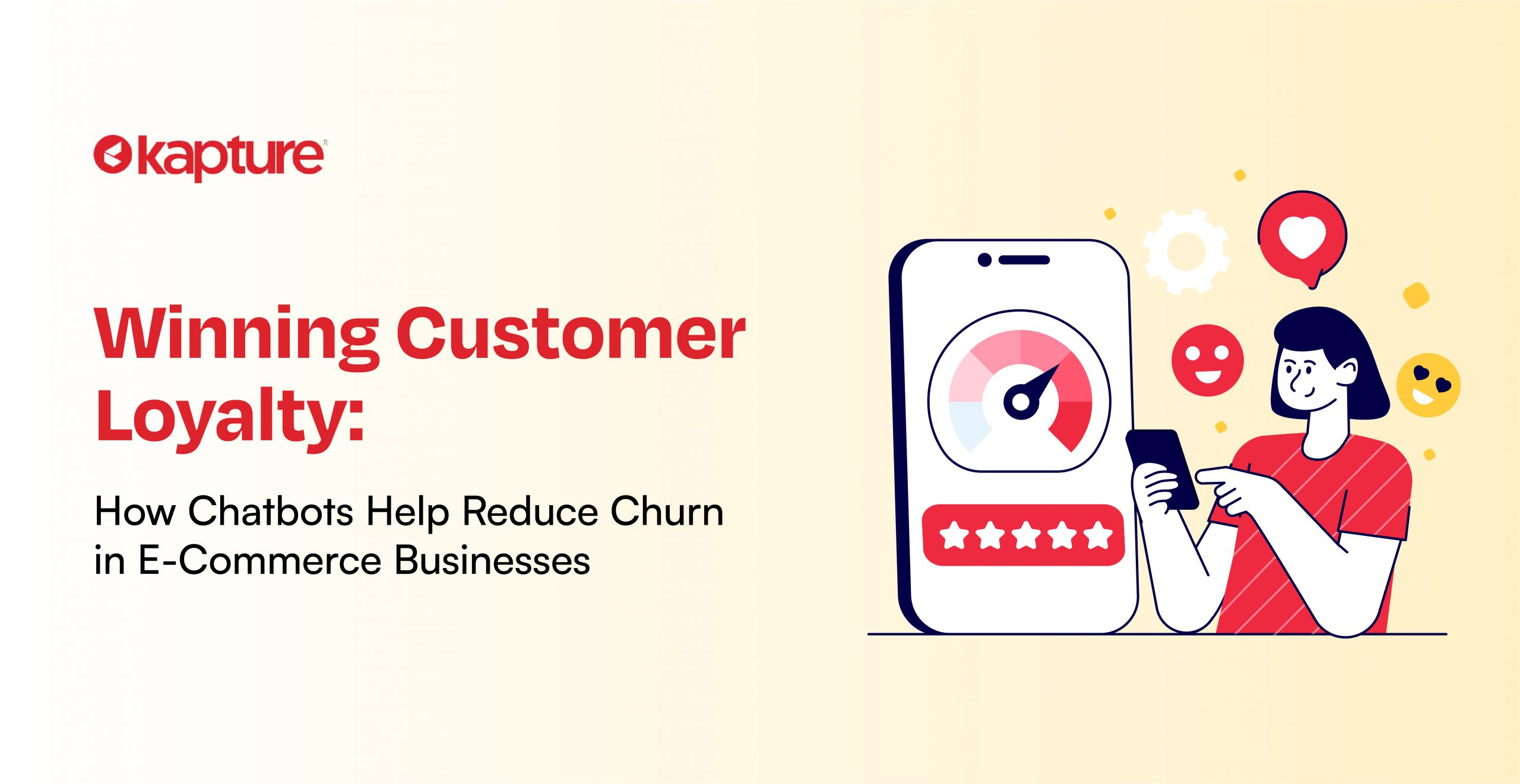Table of Contents
1. What are customer care chatbots?
2. How Chatbots Reduce Customer Churn?
3. Top 5 Advantages of Implementing Customer Care Chatbots
4. Problems and Remedies for Using Customer Care Chatbots
Picture this: After a long workday, a consumer browses your online store on a Friday evening. The items on display immediately attract the customer and decide to purchase them. However, his payment does not process when he attempts to place an order.
Frustrated and unable to find immediate help, he abandons his cart and decides to look at your competitor instead. And just like that, you’ve lost a sale and potentially a loyal customer. The truth is that customers who feel neglected when they need help will almost always shop elsewhere.

Now, picture an alternative scenario: an AI-powered customer care chatbot instantly guides the customer through the issue and resolves the issue within minutes. These virtual assistants allow businesses to provide instant support, efficiently resolve issues, and offer a frictionless shopping experience while keeping customer service teams unburdened.
Gen AI-powered chatbots can accomplish everything from answering routine questions to processing returns, recommending products based on browsing behavior, and re-engaging customers before they churn.
In this blog, we will analyze how chatbots assist e-commerce brands in improving retention, lowering churn, and building long-lasting customer relationships.
What Are Customer Care Chatbots?

Customer care chatbots refer to virtual assistants that help businesses respond promptly to customers’ inquiries. Chatbots are different from conventional customer support assistants, mostly used to handle repetitive inquiries and assist companies throughout their shopping journey. Unlike human agents, who provide personalized service, chatbots are designed for efficiency and speed, streamlining support operations.
There exist two main categories of customer service chatbot:
- Rule-Based Chatbots—These assist customers based on scripted rules with predefined conditions and responses. They work best for repetitive or frequent queries, e.g., order status, refund policy, and store hours.
- AI-Based Chatbots—These are more advanced versions of chatbots that can understand the context, learn from previous interactions, and offer personalized responses. They review customer queries using machine learning and NLP to provide relevant information and enhance the experience with each interaction, offering a more natural and engaging experience.
An efficient chatbot enhances the purchasing experience for the users, decreasing cart cancellations and expediting resolution.
How Chatbots Reduce Customer Churn
Customer churn is a major problem for e-commerce businesses. A delayed or inactive support system will stop customers from interacting with your business. Bots that deliver personalized customer care chat effectively address the issue of customer churn. Here’s how they do it:
1. Instant Responses and 24/7 Availability
Online shoppers find it annoying to wait for assistance to get their basic queries answered. This is where chatbots are helpful, cutting down on waiting times by offering prompt assistance
Consider a situation: For instance, if someone were to inquire, “Where is my order?” The chatbot could retrieve tracking information and deliver an update instantaneously.
Additionally, chatbots can improve the overall online buying experience by quickly answering common frequent questions such as available payment options, refund processes, product availability, etc.
2. Personalized Purchasing Experiences
Companies that genuinely understand the needs of their customers and take measures to satisfy them have a higher chance of success. Gen AI-powered chatbots can help you in this situation.
Personalized chatbots examine surfing histories, previous purchases, and user behavior to provide pertinent recommendations,
For example, when a customer buys skincare products on a regular basis, the chatbot might notify them of restocks, suggest similar skincare products, or give them special discounts on certain brands. Customer retention is encouraged, and consumer engagement is maintained through hyper-personalization.
3. Efficient Issue Resolution
Inefficient resolution processes are a major contributor to customer churn. Chatbots effectively address this by walking customers through some troubleshooting steps, processing their return requests, and escalating more complex issues to human agents if necessary.
Consider a customer having payment issues during checkout. The chatbot can provide real-time assistance by suggesting the customer make use of an alternate payment method or by connecting him/her with a support representative.
4. Proactive Engagement and Follow-ups
E-commerce businesses lose customers for one primary reason: a lapse in follow-up. Customer care chatbots help remind users of abandoned carts, inform customers of restocks, and personalize discounts for conversions.
Chatbots can also follow up with customers for feedback and keep them posted on the status of orders placed. Simple messages like, “Hope you’re enjoying your recent purchase! Let us know if you need any assistance,” can help give value to the customer and build loyalty.
5. Cost-Effective Customer Support
Upgrading a customer support team in peak seasons or when demand is growing can be very expensive. Chatbots can assist companies in handling a large volume of questions without raising operating expenses.
Chatbots can manage thousands of customer inquiries at once during peak seasons like a Christmas sale, including inquiries about products, shipping, and special deals, without putting too much pressure on support agents. Chatbots guarantee prompt assistance for often-asked or repetitive questions, it frees up agents to concentrate on complex and critical conversations.
Top 5 Advantages of Implementing Customer Care Chatbots

Customer care chatbots have completely changed how e-commerce businesses interact with their customers. Providing timely, dependable, and personalized support enhances the shopping experience and reduces attrition. A closer look at the main advantages of incorporating chatbots into customer support operations is provided here.
1. Increased User Satisfaction
With quick and convenient services becoming the norm, chatbots help deliver on such expectations through automation and AI-driven interactions:
- Instant response – Long wait times are unacceptable; a chatbot will always be available to answer repetitive questions.
- Reduced frustration – Rapid access to information regarding orders, returns, and payments minimizes confusion.
- Always-on assistance – Chatbots handling customer care chat eliminates the limitation of working in shifts by offering around-the-clock support to customers in all time zones.
Satisfied customers are bound to be loyal to a brand, and a seamless support experience would instill their trust.
2. Increased Retention Rates
Customers leave a brand primarily due to poor service. Chatbots help retain customers by:
- Providing proactive assistance: Chatbots alert customers in advance of order updates, exclusive offers, or tailored suggestions.
- Recovering lost sales: Offering discounts and reminding customers of cart abandonment motivates them to make a purchase.
- Increasing engagement: After a customer makes a purchase, brands can keep in touch with them through customer care chat, which builds relationships and encourages repeat business.
A valued and engaged customer are more likely to continue doing business with the same brand.
3. Improved Sales and Upselling Opportunities
In addition to answering consumer questions, chatbots help generate income by:
- Customized product suggestions: By making appropriate product suggestions based on a customer’s browsing and past purchase history, chatbots raise the chance of a conversion. A chatbot might suggest a wireless charger or a protective cover, for instance, if a customer orders a smartphone.
- Limited-time offers: Customers will feel the need to make a purchase right away due to the urgency created by exclusive discounts and offers, which lead them to believe they are getting a fantastic deal.
4. Better Resource Allocation
It can be an expensive endeavor to hire and oversee customer service agents, particularly during periods of high demand. Chatbots give companies the freedom to optimize resources by:
- Answering FAQs: Chatbots can answer questions like purchase tracking and refund policy, freeing up human agents to work on more complex issues.
- Preventing Burnout: Chatbots increase productivity by engaging meaningfully with high volumes of customers without compromising service quality. This in turn can go a long way in preventing support agents from getting burned out.
Having the aid of a gen AI-powered chatbot allows businesses to ensure agent productivity is not compromised.
5. Real-Time Insights and Analytics
Understanding customer behavior is crucial for making informed business decisions. Chatbots provide valuable data by:
- Monitoring consumer interactions: By examining consumer interactions and frequent grievances, companies can pinpoint problems and enhance their offerings.
- Measuring customer sentiment: By examining discussions and modifying their strategy, businesses can determine the degree of customer satisfaction.
- Chatbot optimization – Businesses can leverage real-time feedback and engagement patterns to refine chatbot replies and workflows.
With this knowledge, e-commerce brands can iterate their customer experience and retention tactics.
Problems and Remedies for Using Customer Care Chatbots
Although chatbots have revolutionized customer service by offering immediate assistance and facilitating better communication, there are several obstacles to overcome when it comes to deploying them:
1. Limitations in Understanding Natural Language
Training chatbots to accurately comprehend customer inquiries is one of the biggest issues businesses face. The majority of bots are unable to understand slang, complex language structures, or several intents in a single query. Hence, they reply incorrectly to a frustrated user.
Solution:
- Implement a gen AI-powered chatbot capable of learning from its past interactions and, thus able to continuously improve its responses over time to help resolve even the most complex of problems over time.
- Choose solutions incorporating natural language processing (NLP) and contextual learning to achieve greater accuracy.
- To help the chatbot better understand customer inquiries, update its database regularly with relevant data including new product or service details, common customer issues, industry-related terminology and frequently asked questions.
2. Selecting the Ideal Chatbot for Your Company’s Requirements
With a plethora of options available, choosing a chatbot can be difficult. Certain companies use basic chatbots with restricted functionality whereas others use chatbots capable of driving empathetic conversations with the end customer.
Solution:
- Start by determining your main customer service pain points, such as responding to questions about return policy, purchase tracking, or providing tailored recommendations.
- Next, determine if your company would prefer to use an AI-based chatbot (for more complicated interactions) or a rule-based chatbot (for simple queries).
- The chatbot you select should work with the platforms and technologies you currently use for customer service.
3. Finding the Ideal Balance Between Human Support and Automation
Even though chatbots can answer a lot of customer queries, relying too much on automation can occasionally make the experience annoying, particularly when the user has delicate or complicated situations that call for human assistance.
Solution:
- If necessary, use the chatbot’s built-in handoff procedure to transfer the user to a live agent with ease.
- While human agents handle more complicated issues, let chatbots handle regular and frequently requested questions.
- Monitor customer input to modify automation levels according to preferences and needs.
4. Providing a Tailored Customer Experience
Conversations can feel annoying and useless when chatbots don’t perform well. Generic, automated responses are not only inadequate, but they may cause companies to lose hold of their existing customers instead of retaining them.
Solution:
- Use consumer information like browsing history, preferences, and previous purchases to enable your chatbots to customize conversations.
- Chatbots should sound conversational and natural, reflecting the tone of your company
- Responses from chatbots are regularly updated in response to user input and actions, enabling gradual customization enhancements.
5. Overcoming Integration Challenges
Chatbots must be simple to integrate with existing customer care programs, e-commerce platforms, and CRMs. Siloed chatbots are a common problem for businesses, making it difficult for them to offer comprehensive support.
Solution:
- Select a chatbot that works with the helpdesk and customer relationship management (CRM) programs that are already set up in your IT stack.
- Make sure the chatbot has real-time access to customer data so it can respond with pertinent and accurate information.
- Working with chatbot providers that offer API-based interfaces will help you avoid issues with system incompatibility.
Why Opt for Kapture?
Kapture offers companies a full range of services that use chatbots to improve customer support while balancing automation and human assistance. By making the implementation of chatbots easier, it guarantees ongoing customer connections.
Here’s how Kapture helps businesses fix typical chatbot challenges:
- Omnichannel Integration: To offer a smooth support experience, the platform links numerous customer service channels, such as chat, email, social media, and more.
- AI Chatbot: It answers basic questions and seamlessly transfers more complicated problems to real employees when needed.
- Personalized Interactions: Offers proactive support, suggestions, and answers that are specific to each customer.
- Real-time insights and reporting: analyzes customer interactions, identifies issues, and makes recommendations for fixes to enhance engagement strategies.
- Simple Deployment & Scale: The platform’s flexible solutions cater to various businesses’ evolving support requirements.
Final Thoughts
Today e-commerce businesses rely on customer care chatbots to maintain consumer engagement and lower customer turnover. Through proactive support, tailored conversations, and real-time support, these bots reduce consumer discomfort, which may otherwise result in cart abandonment and unsuccessful transactions.
Nevertheless, too much automation is not the solution! A bot can handle routine/frequent inquiries instantly, but human agents must be available when needed to handle escalations.
Many enterprises want to prioritize customer retention—it’s not just a choice but a necessity. Platforms like Kapture provide industry-leading gen AI-powered bots to handle routine customer care chat queries without disrupting the day-to-day activities of business worldwide.
Want to transform your customer experience strategy and take your business to the next level? Switch to Kapture and start reducing the churn that’s holding back your e-commerce growth today.








